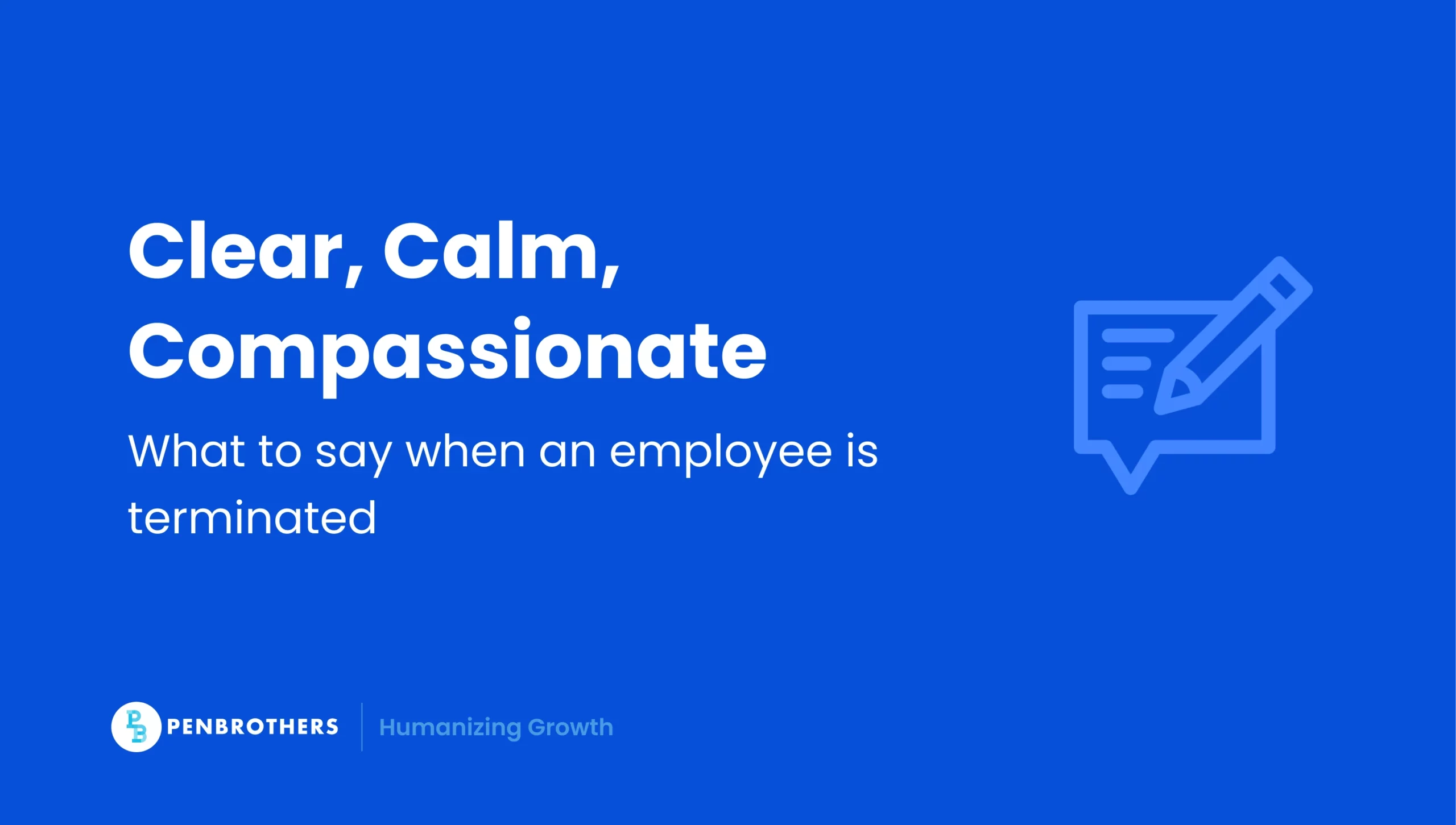What's Inside?
7 Things to Say When an Employee Is Terminated (with Sample Scenarios)

Terminating an employee is never easy. It’s a conversation fraught with emotion, legal implications, and the potential for long-lasting impact on both the individual and the organization. But when that conversation takes place across screens, with miles separating you and the employee, the dynamics shift profoundly. Without the nuances of shared physical space, the reassuring handshake, the subtle body language, or the opportunity for immediate, in-person follow-up. Every word you utter is amplified.
For hiring managers building and leading remote teams, this amplification presents a unique challenge. How do you ensure clarity, maintain compliance, and deliver a message with dignity when your primary communication channel is virtual? Many existing guides cover the basics, but they often miss the subtle yet crucial distinctions of a remote dismissal.
This guide is designed to arm you with precision. We’ll explore the seven essential things you must say when terminating a remote employee, providing not just the what, but the why each phrase is critical in a distributed environment, complete with tailored, remote-specific sample scripts for every scenario.
Key Takeaways
- Clarity and Directness are Paramount in a Remote Setting: In a virtual termination, there is no room for ambiguity. The conversation must be led with clear, direct statements, such as “Today is your last day,” delivered early in the call to establish the finality of the decision without the benefit of physical cues.
- A Scripted, Seven-Point Framework is Essential for Compliance: A successful and legally defensible remote termination follows a structured script. The seven essential communication points cover the statement of termination, its finality, financial and benefit details, asset recovery protocols, the company’s reference policy, a single point of contact for follow-up, and a professional closing.
- Immediate Digital Offboarding is a Critical Security Step: Due to the nature of remote work, security is a major risk during termination. A key part of the process is the “immediate digital disconnect,” where all of the employee’s access to company systems, email, and platforms is revoked the moment the termination call concludes.
- Local Labor Laws Apply to Offshore Teams: A crucial consideration for global teams is that an employer cannot apply their home country’s labor laws to remote employees. For example, terminating a team member in the Philippines requires “due process” as mandated by local law,
Setting the Stage: Pre-Meeting Mental Prep for What You’ll Say
Before you even open the video call, meticulous preparation for your verbal delivery is non-negotiable. In a remote setting, your preparation needs to be even more rigorous than for an in-person meeting.
Rehearsing for Clarity: The Remote Advantage of Preparedness
Winged conversations are the enemy of effective remote terminations. They lead to rambling, inconsistency, and significant legal risk.
- The Remote Reality: On a video call, awkward pauses feel longer, unclear statements are harder to clarify in the moment, and every verbal stumble can erode trust or invite misinterpretation. Your only communication channel is verbal and visual (from a distance).
- Your Solution: Develop a concise script outlining the seven key messages. Practice delivering it aloud, perhaps even recording yourself to refine your tone and pacing for the virtual setting. Use bullet points for critical information (effective dates, benefit details, property return instructions) that you can easily refer to.
- Value Proposition: This pre-emptive rehearsal ensures you deliver a clear, consistent, and legally sound message without wavering, which is paramount when your only real-time interaction is through a screen. It empowers you to remain professional even if the employee becomes emotional or argumentative.
The Role of HR/Witness: A Unified Remote Message
Having a witness or HR representative present is a standard best practice, but their role in a remote termination goes beyond just being an observer. They are a co-deliverer of a unified message.
- The Remote Reality: Disjointed communication or mixed messages between the manager and HR can create confusion, undermine the finality of the decision, and open doors for legal challenges later. Who explains COBRA? Who details the property return?
- Your Solution: Before the meeting, hold a brief huddle with your HR partner. Clearly align on who will deliver each of the seven points. Specifically for remote meetings, pre-determine how HR will be introduced and their precise purpose stated at the outset. For example, “Sarah from HR is here to help ensure we cover all necessary information and answer any procedural questions.”
- Value Proposition: This synchronized approach presents a united front to the employee, reinforces the finality of the decision, and ensures all critical information is covered efficiently without redundancy or omission. It also demonstrates due process, which is harder to convey without physical presence.
7 Things to Say When Terminating a Remote Employee
Maintain a professional, empathetic, yet firm tone. Avoid jargon. Be concise. Remember, in a remote context, silence can be powerful, but too much silence can invite questions you don’t want to answer.
1. “Today is your last day of employment with [Company Name].” (The Direct Statement of Termination)
Why It’s Critical: In a virtual meeting, ambiguity is a dangerous luxury. There are no non-verbal cues like an escort out of the building or the collection of a badge to signal finality. You must lead with absolute clarity to prevent misinterpretation.
- Remote Nuance: Deliver this statement early in the call. Maintain direct eye contact with your camera to convey sincerity and firmness. Avoid preambles that soften the blow too much, as they can dilute the message.
- Sample Script (For Cause – Performance, Remote Context):
“Hi [Employee Name], thank you for joining this meeting today. This is a difficult conversation, but we need to address a serious matter. Today is your last day of employment with [Company Name]. This decision is a direct result of the unaddressed performance issues we’ve discussed repeatedly, specifically [brief, factual example: e.g., ‘your consistent failure to meet documented project deadlines in [project management tool] despite multiple performance improvement plans and coaching sessions over the past three months’].” - Sample Script (At-Will – No Cause/Restructuring, Remote Context):
“Hi [Employee Name], thank you for joining this meeting. This is a difficult call, but we’ve made the decision to end your employment with [Company Name] effective today. This is an at-will decision for business restructuring reasons, and it’s not a reflection of your individual performance.”
2. “This decision is final and not negotiable.” (Establishing Finality)
Why It’s Critical: Without the physical presence to underscore the end of employment, a remote employee might assume there’s room for discussion, negotiation, or pleading. You need to close that door explicitly.
- Remote Nuance: Be prepared for potential emotional reactions or pleas over video. Keep your tone firm but empathetic. Avoid long, awkward silences that might invite attempts to debate the decision. Do not get drawn into a discussion about “what if I promised to do better?”
- Sample Script:
“I understand this is incredibly difficult news, and I want to acknowledge that. Please know that this decision is final and not negotiable. This meeting is solely to provide you with the necessary information for your transition, not to discuss a reversal of the decision.”
If they attempt to push or plead:
“I appreciate that you’re offering solutions, but the company has made its decision. We need to move forward with providing you with the information to ensure a smooth transition.”
3. “Here’s information regarding your final pay, benefits continuation, and accrued time off.” (Financial & Benefit Information)
Why It’s Critical: For remote employees, immediate financial concerns can be heightened as they may not have immediate access to HR or internal resources. Providing clear, immediate information mitigates anxiety and ensures legal compliance across varied state laws.
- Remote Nuance: Be ready to share a summary document (e.g., a PDF of the “Termination Information Packet”) on screen during the call, or verbally confirm its immediate email delivery. Specifically mention remote-relevant benefits or considerations, like potential equipment buy-back policies if applicable. Emphasize when this document will arrive (e.g., “This will hit your personal inbox within the next 15 minutes.”).
- Sample Script:
“Now, let’s discuss your final compensation and benefits. Your final paycheck, including any accrued, unused vacation time as per [state/local law], will be [delivered on/via direct deposit on DATE]. Here is the ‘Termination Information Packet’ [share screen briefly or confirm email] that details your COBRA election options, how to continue any healthcare benefits, and information about unemployment benefits. Please review this carefully, as the deadlines are time-sensitive.”
4. “We need to discuss the return of company property and the immediate deactivation of your access.” (Asset & Security Protocol)
Why It’s Critical: This is where remote terminations introduce significant security and logistical challenges that generic advice often misses. Immediate, secure IT offboarding is paramount to prevent data breaches and protect company assets.
- Remote Nuance: Be highly specific about the logistics of remote asset recovery (e.g., pre-paid shipping labels, specific return addresses) and the precise timing of IT access cut-off. Do not leave this open to interpretation.
- Sample Script:
“Next, we need to address company property and system access, which will be deactivated effective at the conclusion of this meeting. This is crucial for our security protocols. Here is a checklist of items [share screen, or reiterate you’ll email it] that need to be returned, including your company laptop, monitor, keyboard, mouse, and any company-issued peripherals or keys. We have already arranged for a pre-paid shipping label to be emailed to your personal address immediately, along with clear instructions for packaging and return. Please ensure these items are shipped by [Date/Time, e.g., ‘the end of business tomorrow’]. Your access to all company systems, including email, shared drives, and our project management software, will be deactivated as soon as this call ends.”
5. “Our company’s policy for references is [state policy: e.g., neutral verification/dates and title only].” (Future Employment & References)
Why It’s Critical: Without the shared office network, a terminated remote employee might rely more heavily on official company references or, conversely, be more prone to posting negative online reviews. Setting clear expectations for references can mitigate future issues.
- Remote Nuance: Reinforce that the company’s reference policy is standardized and applies uniformly to all employees, regardless of their remote status or the reason for termination. This helps prevent claims of unfair treatment.
- Sample Script (Neutral Reference – Most Common & Safest):
“Regarding future employment, our company policy is to provide neutral verification of employment for all past employees. This typically includes confirming your dates of employment and your official job title. Any requests for references should be directed to [HR Email Address/Department].” - Sample Script (If Offering Outplacement/Re-employment Support, Remote-Specific):
“To support your transition, we are offering [e.g., three months of virtual outplacement services with ABC Career Support]. This includes resume review, virtual interview coaching, and online job search assistance. Details about how to access these services are included in your information packet.”
6. “If you have any questions after this meeting, please direct them to [Specific HR Contact/Email/Phone Number].” (Point of Contact for Follow-Up)
Why It’s Critical: In a remote setup, an employee might feel isolated after termination, leading them to reach out to former colleagues, causing disruption. Providing a single, clear point of contact is essential.
- Remote Nuance: Give a direct email address or phone number that will be monitored by the designated HR person. Avoid ambiguous references like “the HR department,” which can lead to frustrating calls for the employee. Ensure this contact is available for a reasonable period.
- Sample Script:
“I know this is a lot of information to process, and you may have further questions once you’ve had time to review everything. If you do, please direct all questions to [HR Contact Name] at [HR Email Address] or [HR Phone Number]. They are your designated point of contact for any follow-up, and they will be able to assist you with benefits, paperwork, or any other procedural inquiries.”
7. “We wish you well in your future endeavors. That concludes our meeting.” (Professional Closing & Disconnect)
Why It’s Critical: This statement needs to be concise and signal the definitive end of the interaction. In a remote call, you don’t have the luxury of standing up or walking out, so the verbal cue is paramount for a clean break.
- Remote Nuance: Acknowledge the difficulty briefly, keep it brief, and then immediately signal the end of the meeting by concluding the call shortly after this statement. Lingering on the call can invite further attempts at conversation.
- Sample Script:
“We understand this is a very difficult and unexpected conversation, and we acknowledge the impact this will have. We genuinely wish you well in your future endeavors. [Pause briefly, maintain eye contact with camera]. That concludes our meeting. You will receive an email shortly with all the documents we discussed.” [Immediately click ‘End Meeting for All’ or ‘Leave Meeting’].
What NOT to Say (and Why it’s Even More Critical in a Remote Context)
In a remote setting, casual remarks or ill-advised apologies are amplified. Without the context of physical presence, they can be misinterpreted as legal admissions, signs of weakness, or an invitation to argue. Stick rigidly to your prepared script.
- “I’m sorry, this is so hard for me.”
- Remote Danger: This shifts the focus to you, not them. It’s unprofessional and provides no comfort, potentially implying shared suffering that isn’t accurate.
- Remote Danger: This shifts the focus to you, not them. It’s unprofessional and provides no comfort, potentially implying shared suffering that isn’t accurate.
- “We loved working with you, but…”
- Remote Danger: Mixed messages are incredibly confusing on a screen. Avoid sending contradictory signals that can lead to misinterpretation or an employee clinging to false hope.
- Remote Danger: Mixed messages are incredibly confusing on a screen. Avoid sending contradictory signals that can lead to misinterpretation or an employee clinging to false hope.
- “If only you had…”
- Remote Danger: This invites debate, opens the door for blame, and can quickly devolve into an argumentative “he-said, she-said” over video, which is difficult to control.
- Remote Danger: This invites debate, opens the door for blame, and can quickly devolve into an argumentative “he-said, she-said” over video, which is difficult to control.
- “Don’t tell anyone.”
- Remote Danger: This is unenforceable in a distributed team and can breed distrust and resentment among remaining employees. It’s also likely to be ignored.
- Remote Danger: This is unenforceable in a distributed team and can breed distrust and resentment among remaining employees. It’s also likely to be ignored.
- Anything that compares them to others.
- Remote Danger: Such comparisons open the door to discrimination claims. Focus only on the employee’s specific performance or the business decision, not on other team members.
Finalizing the Remote Termination: Immediate Post-Meeting Actions
The conversation is over, but your work isn’t. The minutes immediately following the remote termination call are critical for security and compliance.
The “Immediate Digital Disconnect” Checklist
- The Remote Reality: Delay in access revocation is a massive security risk for remote teams, where digital access is the primary gateway to company data and systems.
- Your Solution: Immediately after clicking ‘End Meeting,’ execute your IT offboarding checklist. This means revoking all system access (SaaS tools, shared drives), company email, VPN access, and internal communication platform permissions. Have IT prepped to do this simultaneously with the meeting’s conclusion.
- Value Proposition: This protects sensitive data and systems from potential malicious or accidental access, mitigating significant security vulnerabilities.
Document Delivery Confirmation for Remote Employees
- The Remote Reality: You can’t hand them a physical packet. Ensuring the employee receives all legally required documents in a timely and trackable manner is paramount.
- Your Solution: Send the complete termination packet (termination letter, COBRA information, severance agreement if applicable, property return instructions/checklist) via secure email to their personal address immediately after the call. Use read receipts or a system that confirms delivery and opens.
- Value Proposition: Provides a clear, indisputable paper trail of compliance, demonstrating that all necessary information was provided as legally required.
Conclusion: The Art of a Dignified Remote Offboarding
Terminating an employee, especially remotely, is inherently challenging. However, by mastering these seven critical verbal cues and supporting them with robust preparation and remote-specific logistical planning, you can navigate even the most difficult conversations with professionalism and dignity.
This precise, empathetic approach safeguards your organization from potential legal ramifications and, perhaps more importantly, protects your employer brand in the remote landscape. A well-executed remote offboarding, even under difficult circumstances, speaks volumes about your company’s values and respect for its people, ultimately contributing to a positive reputation for attracting and retaining talent in the distributed work era.
Frequently Asked Questions
You must begin with a direct and unambiguous statement of termination. A clear sentence like, “Today is your last day of employment with [Company Name],” should be delivered early in the call to prevent any misinterpretation or false hope.
Immediately after the call, you must execute the IT offboarding checklist. This involves revoking the former employee’s access to all company systems, including email, shared drives, software tools, and communication platforms. At the same time, the complete termination packet should be sent to their personal email address.
You should avoid personal apologies that shift focus (e.g., “I’m so sorry, this is hard for me”), mixed messages (e.g., “We loved working with you, but…”), and statements that invite debate or blame (e.g., “If only you had…”). Stick rigidly to the prepared, factual script.
It depends on the issue and, more importantly, on the employee’s local labor laws. While immediate termination may be defensible for egregious misconduct like safety violations or threats, you must still comply with local regulations. For employees in countries like the Philippines, you are required to follow a “due process” procedure, which is not the same as immediate “at-will” termination.
You must have a clear and specific logistical plan. During the termination call, you should inform the employee that they will be emailed a pre-paid shipping label and detailed instructions for packaging and returning all company property by a specific, stated deadline.
*This article was crafted with the support of AI technology and refined by a human editor.





